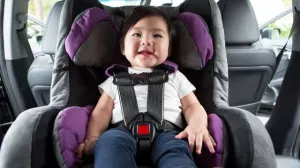What makes a toy dangerous? What do parents of young children need to look for?
Toys can be dangerous for many reasons! For younger children, choking risks are the biggest (pay attention to the ages on the box) and for older children, often toys become dangerous when they are not being used as intended, making them unsafe. Remember – a bike could be a dangerous toy (for example, if a child is riding it unsupervised down a busy street with no helmet) so make sure kids are supervised, use recommended safety equipment and have fun!
What are the risks of toys with button batteries, small pieces, magnets and other hazards? What types of injuries could result from them?
Small toys (such as a game piece) can be a choking hazard for younger children, so in families with two or more kids, be mindful of who else might eventually play with the toy. Strings, cords and ropes can also be dangerous for young children, so buy toys for the suggested age group.
Button batteries are very dangerous to children due to the risk of ingesting the battery and having it get stuck in the esophagus. This is always a medical emergency, as within hours the esophagus can be damaged. A lot of regular household items contain button batteries, in addition to toys, so keep those battery compartments closed and move objects out of the reach of a child if they are exploratory.
Magnets are another very dangerous toy due to the ingestion risk. If two or more batteries are swallowed, they can easily get stuck together and cause intestinal blockage or death. Symptoms may not be obvious at first. Magnets and buttons can both be placed in the ears or nose as well, which can also cause serious injury if left unnoticed.
How often do you see injuries associated with unsafe toys? What is the most common?
Thankfully, on a personal level, it is rare to see injuries with unsafe toys in the outpatient pediatrics office, but every year thousands of children are seen in emergency departments for toy-related injuries! According to the Consumer Product Safety Commission, in both 2020 and 2021, approximately 200,000 children were seen in emergency departments across the country for toy-related injuries. Nearly 75% are under the age of 14 years and close to 40% are less than 4 years old.
Do you know of specific toys that are dangerous for these reasons that might be popular this year?
The most dangerous toys of the year are here! World Against Toys Causing Harm (WATCH) is a non-profit in Massachusetts that puts out an annual list of most dangerous toys – read the list here: https://toysafety.org/press-release-6-14-23/
The take-home message is to be skeptical of toys you may buy for the children in your life. If you think it is unsafe, then don’t get it! In the age of abundant digital media and misinformation, it is also important to recognize that “safety” now includes online safety and privacy. Using some basic principles will help keep you and your family safe this holiday season!
Additional resources
Tip sheet on how to buy safe toys - https://www.healthychildren.org/English/safety-prevention/at-home/Pages/How-to-Buy-Safe-Toys.aspx
Consumer Product Safety Commission - https://www.cpsc.gov/s3fs-public/ToyRelatedDeathsandInjuries2021.pdf
Dr. Hannum is a pediatrician specializing in general pediatrics, adolescent medicine and newborn medicine. He sees patients in Boston.
